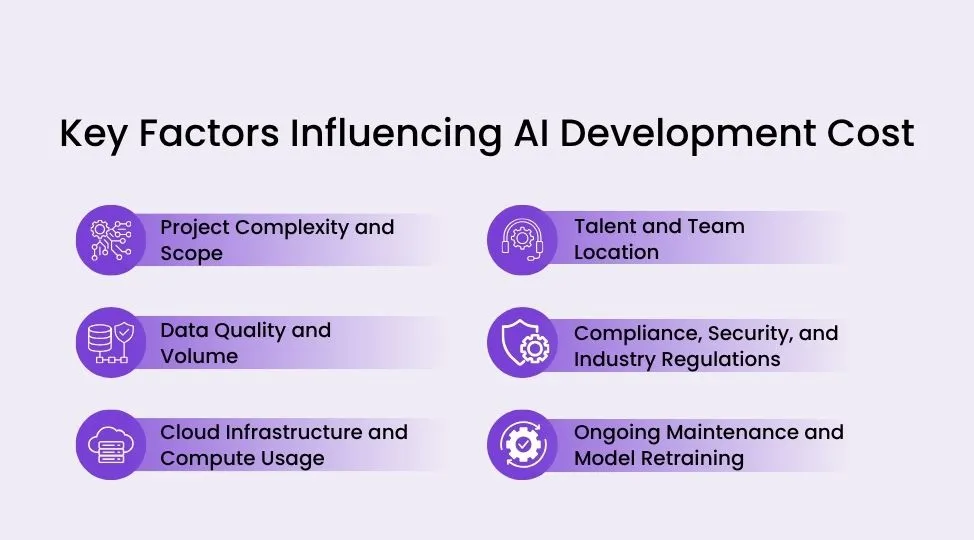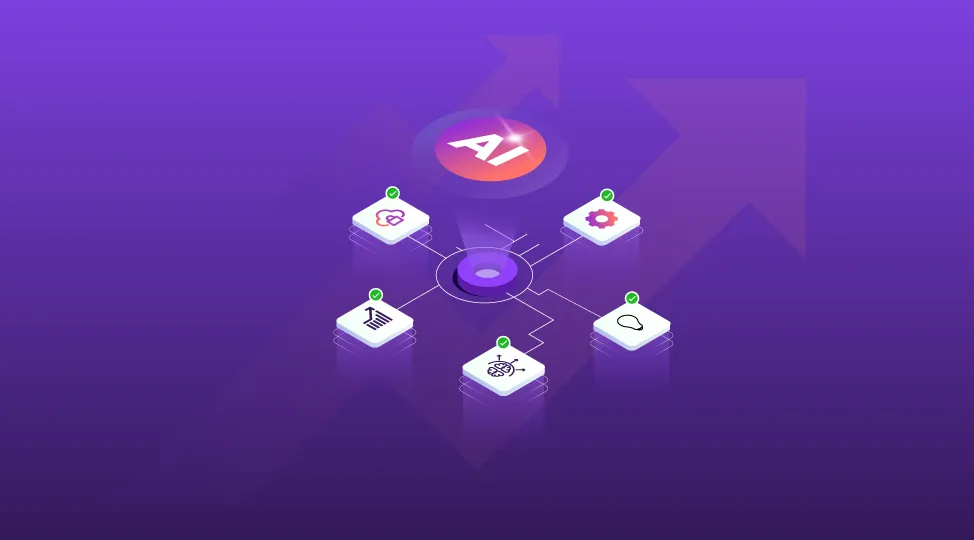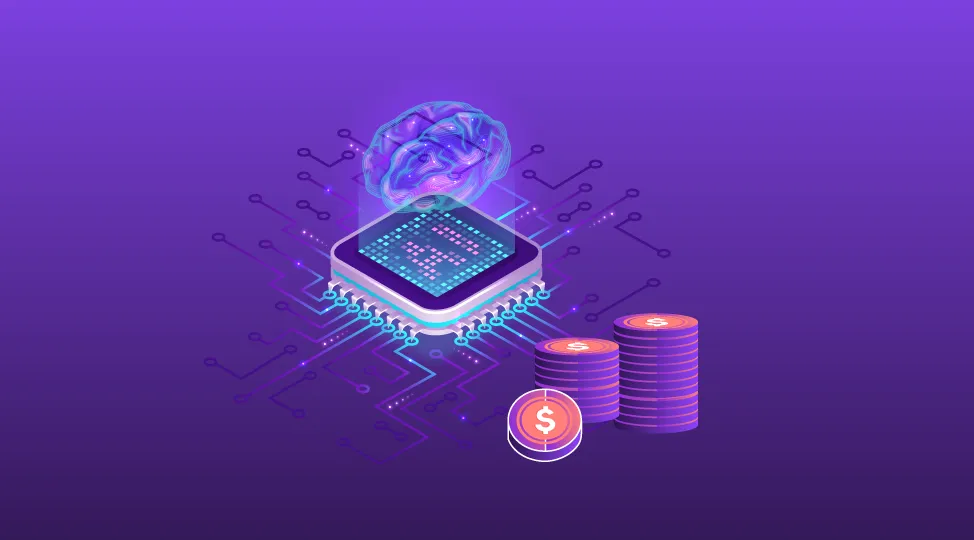Artificial Intelligence

7 min

AI development costs in 2026 range from $10K–$50K for simple tools to $1M+ for enterprise systems. Factors like data quality, complexity, and cloud infrastructure shape pricing. Start with a Minimum Viable AI (MVAI), use pre-trained models, and budget 15–20% annually for maintenance. The goal isn’t just saving cost—it’s maximizing ROI with scalable AI.

By Garima Saxena
11 Nov, 2025
Artificial Intelligence isn’t a luxury anymore; it’s the foundation of competitive advantage. From automating customer interactions to predicting market demand, AI-driven systems are reshaping how businesses operate and scale. But when most executives ask, “How much does AI development cost?”, the answer isn’t simple. A disciplined artificial intelligence cost estimation approach helps decision-makers connect technical scope to business outcomes without guesswork.
The cost of AI implementation depends on far more than just the software itself. Data quality, algorithm complexity, infrastructure setup, and ongoing maintenance all play decisive roles. Building a chatbot prototype can cost a few thousand dollars. At the same time, a large-scale, enterprise-grade AI system, such as predictive analytics for healthcare or fraud detection in finance, can easily reach millions of users.
For businesses planning to develop AI software, the real challenge lies in creating a budget that aligns technology investments with measurable business outcomes. A well-planned AI budget doesn’t just track expenses; it safeguards ROI, ensures scalability, and positions your company for long-term innovation.
In this guide, we’ll break down what truly drives AI development cost, how those costs vary by industry and project scope, and how companies can make smarter financial decisions when investing in AI.
The global AI market is expanding rapidly, but so are the expectations. While computational costs are falling, the demand for specialized talent, high-quality data, and scalable infrastructure continues to rise. This creates a pricing paradox; AI development is becoming both more affordable and more complex simultaneously. Recent data shows that:
The cost of computing power for AI has decreased by over 280 times since 2022, making it easier to experiment with AI prototypes using cloud APIs.
However, AI engineer salaries have increased by nearly 30% during the same period, as companies compete for a limited pool of expertise.
The data annotation market is growing at a 32% CAGR, pushing up costs for training and maintaining advanced AI models.
In short, while small businesses can now afford basic AI features, custom and enterprise-grade solutions remain premium investments where strategy and architecture matter as much as technology.
| Project Complexity | Example Solutions | Estimated Cost (USD) | Timeline |
|---|---|---|---|
| Simple AI Features / Proof of Concept | Basic chatbots, rule-based automation, early-stage prototypes | $10,000 – $50,000+ | 1–2 months |
| Moderate Complexity / MVP | Predictive analytics systems, recommendation engines, small GenAI tools | $50,000 – $250,000+ | 2–4 months |
| Advanced AI Solutions | Computer Vision, NLP pipelines, deep learning models | $150,000 – $500,000+ | 4–6 months |
| Enterprise-Grade / Complex AI | Scalable multi-modal AI, enterprise SaaS, real-time generative systems | $250,000 – $1,000,000+ | 6–12 months |
These estimates vary depending on your data maturity, integration complexity, and infrastructure choices (cloud vs on-premises). For instance, leveraging pre-trained models or APIs can significantly reduce the cost of AI software development, while custom model training requires a higher investment in both data and engineering. For founders and product owners, aligning these ranges to a realistic ai app development cost model early prevents under-scoping and rushed compromises later.
To obtain an accurate forecast, companies typically initiate an AI consultation phase, where feasibility, scope, and ROI potential are assessed before any code is written. This discovery process also improves ai project cost estimation by clarifying assumptions around data readiness, integrations, and rollout requirements.
Explore our AI Consulting Services to understand how strategic cost planning reduces uncertainty and accelerates delivery.
Why the Same AI Idea Can Cost $50,000 or $500,000
To obtain an accurate forecast, companies typically initiate an AI consultation phase, where feasibility, scope, and ROI potential are assessed before any code is written. This discovery process also improves ai project cost estimation by clarifying assumptions around data readiness, integrations, and rollout requirements.

1. Project Complexity and Scope
Every layer of intelligence you add multiplies the cost. A simple chatbot that utilizes predefined rules can be built in a few weeks. But a self-learning predictive model that integrates with multiple data systems, re-trains on new inputs, and provides real-time analytics can take months of R&D.
Complexity affects:
Architecture design: Simple automation can use pre-trained APIs, while advanced solutions need custom model development.
Integration depth: Connecting AI to CRM, ERP, or IoT platforms requires more engineering time.
Testing cycles: High-stakes systems (like healthcare or finance) require multiple validation loops before deployment.
When in doubt, start with a Minimum Viable AI (MVAI) — a lean proof of concept that validates value before scaling to full development.
2. Data Quality and Volume
AI systems thrive or fail based on their data. Collecting, cleaning, and labeling data can account for up to 30–50% of the total AI software development cost.
Poor data leads to inaccurate predictions and increased retraining expenses in the future. To reduce costs, businesses can:
If you’re building from scratch, it’s worth consulting specialists who can design a data pipeline strategy early, something Quokka Labs’ AI Development Services cover as part of project planning.
3. Cloud Infrastructure and Compute Usage
AI models require significant computing power, especially during training. Cloud platforms like AWS, Google Cloud, and Azure now offer pay-as-you-go AI infrastructure, making it easier to control initial costs; however, long-term expenses can spike without careful monitoring. Compute costs depend on:
Smart planning involves setting clear usage limits and adopting hybrid deployment models — keeping critical workloads on-premises while running experiments in the cloud.
4. Talent and Team Location
AI expertise is in short supply. Hiring an in-house team with AI engineers, data scientists, and ML Ops specialists can be costly, especially in North America or Western Europe.
Outsourcing to a trusted technology partner in regions such as India, Eastern Europe, or Southeast Asia can reduce overall AI implementation costs by 40–60% while maintaining quality.
Quokka Labs’ Dedicated Development Teams model provides businesses with access to cross-functional AI specialists without long-term hiring commitments, and a flexible approach to balancing cost and capability.
5. Compliance, Security, and Industry Regulations
Sectors such as healthcare, finance, and telecommunications require strict adherence to laws like HIPAA, GDPR, or PCI DSS. Integrating data encryption, access controls, and audit systems can increase development timelines, but non-compliance costs far more in penalties and lost trust. Embedding security early in the design phase reduces rework and ensures alignment with AI ethics and privacy principles.
💡Suggested Read: Learn more about How to Stay Compliant With AI Security and AI Governance
6. Ongoing Maintenance and Model Retraining
AI isn’t a one-time build — it evolves. Models degrade over time as new data emerges. Continuous monitoring, retraining, and fine-tuning are crucial for maintaining accurate predictions.
Budgeting 15–20% of your initial build cost for annual maintenance is standard practice. This includes:
Long-term sustainability is what separates pilot projects from successful AI transformation.
Every industry utilizes AI differently, which is why there’s no universal price tag. Whether you’re automating patient diagnostics, detecting fraud, or optimizing supply chains, the AI development cost depends on your data readiness, regulatory environment, and operational goals.
Here’s a quick overview of what companies typically spend across sectors:
| Industry | Example AI Applications | Estimated Cost Range (USD) |
|---|---|---|
| Healthcare | Predictive analytics, diagnostics, virtual assistants | $15,000 – $150,000+ |
| Fintech | Fraud detection, credit scoring, and robo-advisors | $30,000 – $250,000+ |
| Retail & eCommerce | Recommendation engines, dynamic pricing, chatbots | $20,000 – $150,000+ |
| Manufacturing | Predictive maintenance, quality assurance, robotics | $30,000 – $250,000+ |
| Logistics & Automotive | Route optimization, fleet management, automation | $15,000 – $120,000+ |
| Real Estate | Valuation models, virtual assistants, trend analysis | $20,000 – $150,000+ |
| Telecommunications | Churn prediction, network optimization, AI support | $25,000 – $400,000+ |
| Education | Adaptive learning, grading automation, virtual tutors | $8,000 – $50,000+ |
These are broad ranges — real-world costs fluctuate based on project scope, integration depth, and choice between custom AI software development or pre-trained APIs. Now, let’s examine how these costs are applied in real-world use cases.
Healthcare AI requires precision, privacy, and regulatory compliance — all of which influence cost.
Average Range: $15,000 – $150,000+
Applications:
Real-World Insight: McKinsey estimates that AI could save the U.S. healthcare system over $150 billion annually through automation and predictive insights; however, compliance readiness remains the most significant cost driver.
The financial industry invests heavily in AI for risk reduction and customer intelligence.
Average Range: $30,000 – $250,000+
Applications:
Real-World Example: JPMorgan Chase utilizes AI-driven fraud detection systems that can scan billions of transactions daily.
Retail AI focuses on personalization and pricing intelligence — both powerful levers for conversion and retention.
Average Range: $20,000 – $150,000+
Applications:
Real-World Example: Amazon attributes over 35% of its revenue to its AI recommendation system.
In manufacturing, the cost of AI is directly tied to the extent of its integration into production lines.
Average Range: $30,000 – $250,000+
Applications:
Real-World Example: BMW utilizes AI vision systems to identify defects more quickly than human inspectors.
Here, the emphasis is on speed, efficiency, and predictive management.
Average Range: $15,000 – $120,000+
Applications:
Real-World Example: Amazon deploys AI-powered robots across its fulfillment centers to reduce sorting time by 20–30%.
Real estate AI focuses on decision intelligence, helping investors, buyers, and agents make faster, data-driven choices.
Average Range: $20,000 – $150,000+
Applications:
Real-World Example: Zillow’s Zestimate tool leverages AI to analyze over 7.5 million listings daily.
AI enables telecom providers to enhance network uptime and reduce churn, often at a large scale.
Average Range: $25,000 – $400,000+
Applications:
Real-World Example: Verizon uses AI monitoring systems that detect network anomalies 20% faster than human-led teams.
Education AI democratizes personalized learning and reduces administrative load for institutions.
Average Range: $8,000 – $50,000+
Applications:
Real-World Example: Carnegie Learning’s MATHia software uses AI to personalize math education across thousands of schools.
Selecting the proper pricing approach is as important as choosing the exemplary model architecture. The same AI project can double or halve its cost, depending on how the agreement is structured. Let’s examine the four models most businesses use when planning AI software development costs. Strong governance during procurement also supports accurate ai project cost estimation across milestones and change requests.
Ideal for projects with a defined scope and milestones.
How it works: You and your development partner agree on clear deliverables and a single upfront cost.
Pros: Budget certainty, minimal scope drift.
Cons: Limited flexibility if the project evolves mid-way.
Best for: Proof-of-concept builds or pilot programs that validate feasibility.
Best suited for evolving projects where requirements are likely to change.
How it works: You pay for actual hours and resources consumed.
Pros: High flexibility, easier iteration, agile progress tracking.
Cons: Cost predictability depends on governance discipline.
Best for: R&D-heavy AI or when the end product will evolve through experimentation
This model provides a full-time AI unit, comprising engineers, data scientists, and project managers, who work exclusively for your company.
Pros: Deep collaboration, faster iterations, strong IP control.
Cons: Higher monthly burn if resource utilization isn’t managed.
Best for: Enterprises scaling multiple AI systems simultaneously.
A relatively new model where payments are tied to measurable business outcomes—accuracy scores, time saved, or revenue uplift.
Pros: Forces alignment between vendor success and your KPIs.
Cons: Requires strong tracking systems and clear metrics.
Best for: Mature organizations that can quantify AI ROI precisely.
Even with a solid pricing model, unseen expenses can derail a budget. Smart planners account for these from day one:
A structured AI partner builds these elements into the project roadmap so you don’t face mid-cycle surprises. Hidden line items are also a common reason the cost of ai implementation rises after launch if they aren’t planned upfront.
The real question isn’t “How much does AI development cost?” — it’s “How much value can the right AI investment return?”
AI isn’t just a line item in your tech budget. It’s a long-term capability that compounds efficiency, customer insight, and innovation. Businesses that plan their AI initiatives around strategic outcomes, rather than just software deliverables, see higher adoption rates and faster ROI. When scoping product roadmaps, treating early budgeting as a true ai app development cost strategy helps teams scale responsibly without sacrificing quality.
At Quokka Labs, our approach combines financial clarity, technical excellence, and continuous optimization. We help organizations build AI systems that not only launch successfully but also sustain results, evolve with data, and create measurable business impact year after year. So before you set your next AI budget, ask:
1. What is the average cost of AI development?
Costs vary based on complexity, ranging from $10,000 for simple chatbots to over $1,000,000 for enterprise-grade AI platforms that integrate multiple data sources and models.
2. What factors influence AI software development cost the most?
Key cost drivers include data quality, project complexity, compute usage, team expertise, and ongoing maintenance.
3. How long does it take to develop AI software?
Typically, 1–2 months for prototypes, 3–6 months for MVPs, and 6–12 months for enterprise deployments.
4. How can businesses reduce AI development costs?
Start with a clear ROI roadmap, use pre-trained models where possible, and partner with an experienced AI consulting company to prevent rework and overspending.
5. Why choose Quokka Labs for AI development?
We combine deep technical expertise with business-first thinking, providing transparent pricing, strategic consulting, and end-to-end delivery across various industries.
Generative AI Tech Stacks: Choosing the Right Tools for Scalable AI Development
By Dhruv Joshi
5 min read
Choosing Best Tech Stack for Web App Development: Performance, Cost, and Scalability
By Dhruv Joshi
5 min read
Top 9 Tech Stacks for Scalable Web Application Development
By Dhruv Joshi
5 min read
Generative AI Implementation Strategy: From Concept to Deployment (Step-by-Step Guide)
By Sannidhya Sharma
5 min read

Artificial Intelligence

5 min
Learn how to choose a generative AI tech stack that scales without surprise costs. This guide maps stack layers - data, models, frameworks, deployment, and governance - explains selection criteria, highlights best practices for latency and cost, and flags common pitfalls.


Artificial Intelligence

5 min
Generative AI only works at scale when you follow a clear strategy, not scattered experiments. This blog walks through a structured Generative AI implementation roadmap—from use case ideation and data prep to model selection, deployment, and ongoing monitoring—while highlighting common pitfalls and how AI consultancy / generative AI development services can speed up a successful, ROI-focused AI product launch.


Artificial Intelligence

5 min
Clear guidance to budget Generative AI in 2026: small pilots cost ~$20k–$60k, mid-size apps ~$60k–$250k+, enterprise programs ~$400k–$1M+. Costs hinge on scope, model choice, data work, integrations, and operations. Use a line-item plan and a simple estimator to forecast build and run-rate. Start with an MVP, track tokens, plan MLOps, and phase delivery. Control security, monitor drift, align to KPIs.


Feeling lost!! Book a slot and get answers to all your industry-relevant doubts